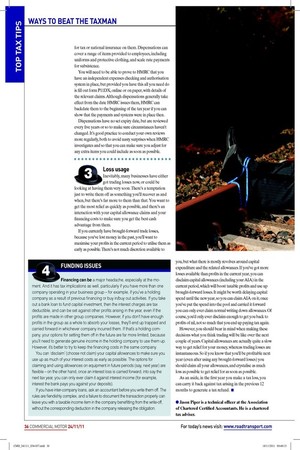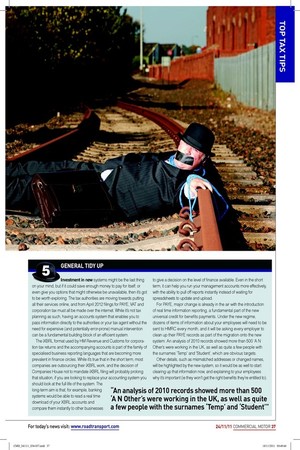Top tips to keep
Page 27

Page 28

Page 29

If you've noticed an error in this article please click here to report it so we can fix it.
your dosh!
Keeping on top of your tax obligations will benefit not only your company but also your staff. We highlight five key areas where you can legitimately make savings
Words: Jason Piper / Images: Tom Cunningham Paying taxes is a fact of life. In the case of corporation tax, you could even argue that it’s a good thing – after all, you only pay taxes if your company is making proits. Still, there’s no compulsion to pay more than the law requires, and even less reason to waste money on unnecessary administration, interest or enquiry costs.
It’s worth remembering that tax is complex, and changes regularly, so in the long run it will almost certainly pay you to ind an expert who understands the issues faced by your kind of business.
Here, then, are ive areas where your business can make tax savings – legitimately.
Dispensations
If you’ve got employees, then you’ll know how time consuming and complicated PAYE reporting is. Even if you use a payroll agency, it’s still oficially your responsibility to get the igures right, something that HM Revenue & Customs (HMRC) and the agency will remind you of if there are any problems. It’s well worth looking at agreeing as much of the work as you can ahead of time, and a dispensation from HMRC can help here.
Dispensations are issued when HMRC is satisied that the expenses or beneits are covered by an allowable deduction and that no tax would be due. As a result, dispensations have two advantages – irst, there’s no need to report the expenses or beneits they cover on the employees’ P11Ds, and second, you don’t need to account
2
CAPITAL ALLOWANCES
Capital allowances have become less generous in recent years. However, it’s important to make sure you claim everything you can, and as early as possible.
Every company is entitled to an annual investment allowance (AIA), which you must remember to claim first against any capital expenditure in the year. The AIA gives you 100% relief in the year of expenditure, so it could well be more effective in the medium term to borrow cash to fund the capital expenditure than to take out a finance lease. You’ll need to do the sums based on your own effective rates of interest though and to consider how long you’d be keeping the assets for.
Check on the timing of your expenditure as well – a common pitfall with hire purchase assets is that they are ‘bought’ in one year, but might not actually be brought into use until the following year. Beware: this scenario could mean that you can’t claim the allowances until the year of use.
Perhaps most fundamentally though, check what you are claiming. Vehicles obviously count (although personalised plates do not) but what about the yard and buildings? Traditionally, HMRC has been reluctant to accept that you can claim for any part of a yard, but if there’s any machinery involved – washing gear, weighbridges, inspection pits and the like – you might be able to claim. And don’t forget that repairs can be written off in the year, regardless. Repairs include bringing premises and equipment up to modern standards, for example, replacing a damaged single-glazed window with modern double glazing, or replacing a constantly leaking flat roof with one that does not leak – although you might have to argue the point on that one. As always, keep records of any expenditure. for tax or national insurance on them. Dispensations can cover a range of items provided to employees, including uniforms and protective clothing, and scale rate payments for subsistence.
You will need to be able to prove to HMRC that you have an independent expenses checking and authorisation system in place, but provided you have this all you need do is ill out form P11DX, online or on paper, with details of the relevant claims. Although dispensations generally take effect from the date HMRC issues them, HMRC can backdate them to the beginning of the tax year if you can show that the payments and systems were in place then.
Dispensations have no set expiry date, but are reviewed every ive years or so to make sure circumstances haven’t changed. It’s good practice to conduct your own reviews more regularly, both to avoid nasty surprises when HMRC investigates and so that you can make sure you adjust for any extra items you could include as soon as possible.
3
Loss usage
Inevitably, many businesses have either got trading losses now, or could be looking at having them very soon. There’s a temptation just to write them off as something you’ll recover as and when, but there’s far more to them than that. You want to get the most relief as quickly as possible, and there’s an interaction with your capital allowance claims and your inancing costs to make sure you get the best cash advantage from them.
If you currently have brought-forward trade losses, because you’ve lost money in the past, you’ll want to maximise your proits in the current period to utilise them as early as possible. There’s not much discretion available to
4
FUNDING ISSUES
Financing can be a major headache, especially at the moment. And it has tax implications as well, particularly if you have more than one company operating in your business group – for example, if you’ve a holding company as a result of previous financing or buy in/buy out activities. If you take out a bank loan to fund capital investment, then the interest charges are tax deductible, and can be set against other profits arising in the year, even if the profits are made in other group companies. However, if you don’t have enough profits in the group as a whole to absorb your losses, they’ll end up trapped and carried forward in whichever company incurred them. If that’s a holding company, your options for setting them off in the future are far more limited, because you’ll need to generate genuine income in the holding company to use them up. However, it’s better to try to keep the financing costs in the same company.
You can ‘disclaim’ (choose not claim) your capital allowances to make sure you use up as much of your interest costs as early as possible. The options for claiming and using allowances on equipment in future periods (say, next year) are flexible – on the other hand, once an interest loss is carried forward, into say the next tax year, you can only ever claim it against interest income (for example, interest the bank pays you against your deposits).
If you have inter-company loans, ask an accountant before you write them off. The rules are fiendishly complex, and a failure to document the transaction properly can leave you with a taxable income item in the company benefitting from the write-off, without the corresponding deduction in the company releasing the obligation. you, but what there is mostly revolves around capital expenditure and the related allowances. If you’ve got more losses available than proits in the current year, you can disclaim capital allowances (including your AIA) in the current period, which will boost taxable proits and use up brought-forward losses. It might be worth delaying capital spend until the new year, so you can claim AIA on it; once you’ve put the spend into the pool and carried it forward you can only ever claim normal writing down allowances. Of course, you’d only ever disclaim enough to get you back to proits of nil, not so much that you end up paying tax again.
However, you should bear in mind when making these decisions what you think trading will be like over the next couple of years. Capital allowances are actually quite a slow way to get relief for your money, whereas trading losses are instantaneous. So if you know that you’ll be proitable next year (even after using any brought-forward losses) you should claim all your allowances, and crystalise as much loss as possible to get relief for as soon as possible.
As an aside, in the irst year you make a tax loss, you can carry it back against tax arising in the previous 12 months to generate a tax refund. n l Jason Piper is a technical oficer at the Association of Chartered Certiied Accountants. He is a chartered tax adviser.
5
GENERAL TIDY UP
Investment in new systems might be the last thing on your mind, but if it could save enough money to pay for itself, or even give you options that might otherwise be unavailable, then it’s got to be worth exploring. The tax authorities are moving towards putting all their services online, and from April 2012 filings for PAYE, VAT and corporation tax must all be made over the internet. While it’s not tax planning as such, having an accounts system that enables you to pass information directly to the authorities or your tax agent without the need for expensive (and potentially error-prone) manual intervention can be a fundamental building block of an efficient system.
The iXBRL format used by HM Revenue and Customs for corporation tax returns and the accompanying accounts is part of the family of specialised business reporting languages that are becoming more prevalent in finance circles. While it’s true that in the short term, most companies are outsourcing their iXBRL work, and the decision of Companies House not to mandate iXBRL filing will probably prolong that situation, if you are looking to replace your accounting system you should look at the full life of the system. The long-term aim is that, for example, banking systems would be able to read a real time download of your XBRL accounts and compare them instantly to other businesses to give a decision on the level of finance available. Even in the short term, it can help you run your management accounts more effectively, with the ability to pull off reports instantly instead of waiting for spreadsheets to update and upload.
For PAYE, major change is already in the air with the introduction of real time information reporting, a fundamental part of the new universal credit for benefits payments. Under the new regime, dozens of items of information about your employees will need to be sent to HMRC every month, and it will be asking every employer to clean up their PAYE records as part of the migration onto the new system. An analysis of 2010 records showed more than 500 ‘A N Other’s were working in the UK, as well as quite a few people with the surnames 'Temp' and 'Student', which are obvious targets.
Other details, such as mismatched addresses or changed names, will be highlighted by the new system, so it would be as well to start clearing up that information now, and explaining to your employees why it’s important (ie they won’t get the right benefits they’re entitled to).













































